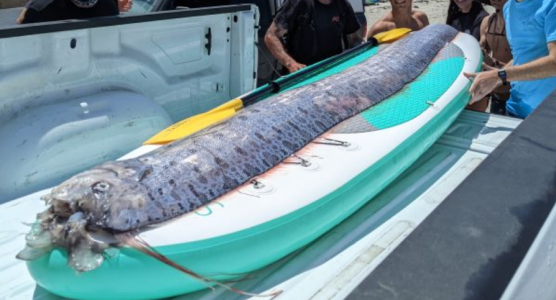Mystery from the Depths: The Legendary Fish Has Washed Ashore—What's the Terrifying Theory Behind It?
By
Gian T
- Replies 7
In the ocean's vast mysteries, few creatures capture the imagination quite like the elusive oarfish, a species that has long been shrouded in myth and legend. Recently, discovering a giant oarfish washed up on a rocky beach in Southern California has reignited interest and speculation about this enigmatic deep-sea dweller. This marks the second time this year that the remains of the rarely encountered species have been documented off the southern Californian coast, and scientists are piecing together a theory that might explain these unusual occurrences.
For centuries, the oarfish has been the subject of dark legends, with some cultures linking the species to ominous events such as earthquakes and other natural disasters. This association has earned the unnerving nickname of the 'doomsday fish.' While no scientific evidence supports the idea that oarfish appearances are harbingers of calamity, their sudden presence in shallow waters raises questions. After the first oarfish discovery near San Diego in August, a 4.4-magnitude earthquake was detected in Los Angeles, which only fueled local superstitions and discussions about the ancient lore.
The latest oarfish discovery occurred at Grandview Beach in San Diego County, where a student from the Scripps Institution of Oceanography found a three-meter-long specimen. The same institute analysed the previous specimen. The body was promptly collected and transported to a research facility for examination. While the cause of death remains a mystery, Ben Frable, the institute's marine vertebrate collection manager, has proposed two possible theories.
Frable suggests that the stranding of these deep-water fish could be related to changes in ocean conditions, including increased oarfish near the coast. Researchers have considered this possibility, but other factors are at play. Broader shifts, such as the El Niño and La Niña climate cycles, may also play a role, although the connection is unclear. A weak El Niño event was recorded earlier this year, which could have influenced marine life patterns.
Another intriguing factor is the recent red tide, an algal bloom that produces toxins lethal to humans, marine life, and birds. Additionally, the coast was hit by the powerful and dry Santa Ana winds, colloquially known as 'Devil winds.' These winds can cause upwelling, bringing cold water from the depths to the surface and potentially affecting marine life. They are also known to influence human moods and, during warmer months, can exacerbate wildfires.
'Many variables could lead to these strandings,' Frable noted, acknowledging the ocean's ecosystem's complexity and the many factors that could contribute to such rare events.
Interestingly, two Australian fishermen encountered an oarfish off the Top End in September, a reminder that these mysterious creatures can appear in waters far from their usual deep-sea habitats. The long, slender fish is a rare sight in Australian waters, adding to the intrigue and fascination surrounding these sea serpents of the deep.
 As members of the Seniors Discount Club, we have a special appreciation for the wonders of nature and the mysteries that remain unsolved. The story of the oarfish is a reminder of the ocean's vast and uncharted territories, where legends still roam free. What do you think about the oarfish and its legendary status? Have you ever encountered any rare or unusual marine life? Share your stories and thoughts with us in the comments below, and let's marvel together at Australia's—and the world's—weird and wonderful environment.
As members of the Seniors Discount Club, we have a special appreciation for the wonders of nature and the mysteries that remain unsolved. The story of the oarfish is a reminder of the ocean's vast and uncharted territories, where legends still roam free. What do you think about the oarfish and its legendary status? Have you ever encountered any rare or unusual marine life? Share your stories and thoughts with us in the comments below, and let's marvel together at Australia's—and the world's—weird and wonderful environment.
For centuries, the oarfish has been the subject of dark legends, with some cultures linking the species to ominous events such as earthquakes and other natural disasters. This association has earned the unnerving nickname of the 'doomsday fish.' While no scientific evidence supports the idea that oarfish appearances are harbingers of calamity, their sudden presence in shallow waters raises questions. After the first oarfish discovery near San Diego in August, a 4.4-magnitude earthquake was detected in Los Angeles, which only fueled local superstitions and discussions about the ancient lore.
The latest oarfish discovery occurred at Grandview Beach in San Diego County, where a student from the Scripps Institution of Oceanography found a three-meter-long specimen. The same institute analysed the previous specimen. The body was promptly collected and transported to a research facility for examination. While the cause of death remains a mystery, Ben Frable, the institute's marine vertebrate collection manager, has proposed two possible theories.
Frable suggests that the stranding of these deep-water fish could be related to changes in ocean conditions, including increased oarfish near the coast. Researchers have considered this possibility, but other factors are at play. Broader shifts, such as the El Niño and La Niña climate cycles, may also play a role, although the connection is unclear. A weak El Niño event was recorded earlier this year, which could have influenced marine life patterns.
Another intriguing factor is the recent red tide, an algal bloom that produces toxins lethal to humans, marine life, and birds. Additionally, the coast was hit by the powerful and dry Santa Ana winds, colloquially known as 'Devil winds.' These winds can cause upwelling, bringing cold water from the depths to the surface and potentially affecting marine life. They are also known to influence human moods and, during warmer months, can exacerbate wildfires.
'Many variables could lead to these strandings,' Frable noted, acknowledging the ocean's ecosystem's complexity and the many factors that could contribute to such rare events.
Interestingly, two Australian fishermen encountered an oarfish off the Top End in September, a reminder that these mysterious creatures can appear in waters far from their usual deep-sea habitats. The long, slender fish is a rare sight in Australian waters, adding to the intrigue and fascination surrounding these sea serpents of the deep.
Key Takeaways
- A giant oarfish washed up on a Californian beach, sparking interest in the species' rare appearances and the old superstitions surrounding them.
- Scientists are investigating why these deep-sea creatures are stranding on beaches, with some suggestions linking the phenomenon to changes in ocean conditions or seismic activity.
- The Scripps Institution of Oceanography is analysing the three-metre-long specimen found at Grandview Beach to determine the cause of death and any possible links to environmental factors.
- The beaching of the oarfish coincided with the red tide and strong Santa Ana winds, which could be contributing factors to the stranding of deep-sea species.









